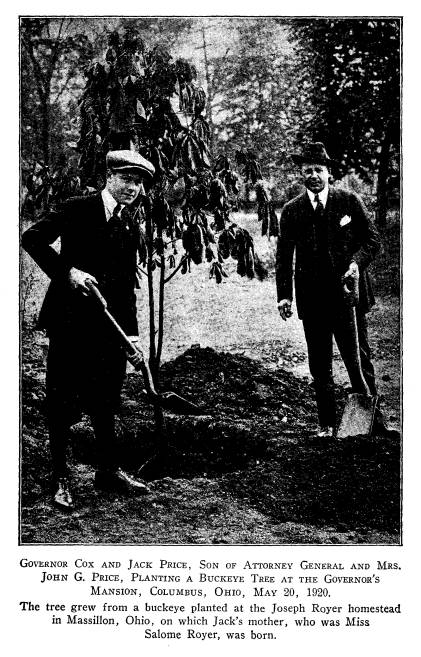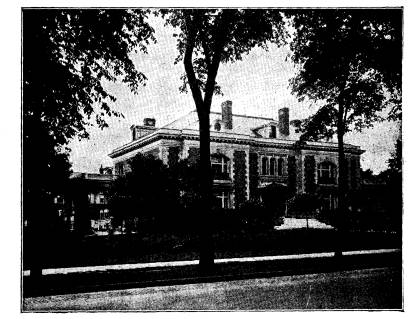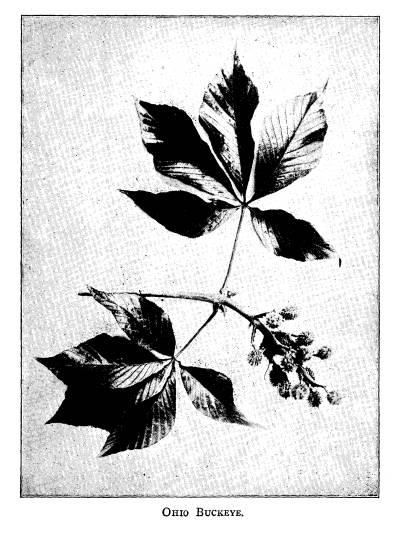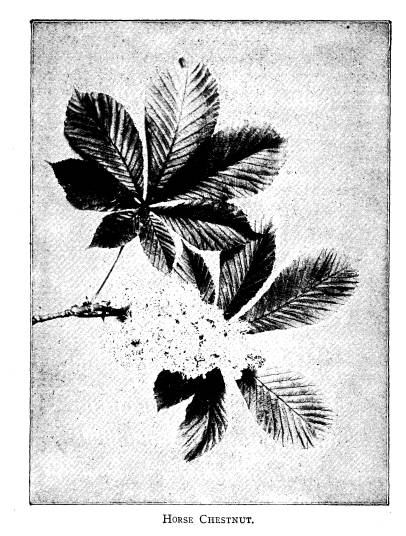Ohio History Journal
|
EXECUTIVE MANSION. Here is presented a cut of the attractive and substantial building that was erected by C. H. Lindenberg at 1234 East Broad street in 1904 and occupied by him from April, 1905, until the title of the property passed to the state in 1919. It is a com- modious mansion of about thirty rooms appropriately furnished. |
|
|
|
After the property was acquired by the state the interior of the building was remodeled and an additional adjacent tract of land purchased for eighteen thousand dollars was made a part of the mansion grounds. It was occupied as a governor's resi- dence early in 1920. Briefly stated the legislative history of the acquisition of the property is as follows: The building of an executive mansion had at different times been recommended in governors' messages and action to carry (270) |
Executive Mansion. 271
such recommendation into effect had been
taken or attempted by
the general assembly.
On February 16, 1917 a resolution was
adopted authorizing
the appointment of a committee to
"investigate the cost of pur-
chasing a residence already erected and
also the cost of pur-
chasing a site and causing a proper
residence to be erected there-
on" in Columbus "to be used as
a home for future governors of
the state". (107 0. L. 760.)
On March 30, 1917 the governor approved
an act authoriz-
ing an Executive Mansion Board and
appropriating one hundred
and twenty-five thousand dollars to
purchase a site and erect there-
on "a building for use as a home
for the future governors of the
state".
Under the provisions of this act a site
was purchased. It
later appeared desirable to acquire a
different site with a building
already erected. Accordingly on February
26, 1919 the gov-
ernor approved an act amending the act
of March 30, 1917 and
authorizing the board
"To purchase a dwelling in the city
of Columbus, with the
grounds pertaining thereto, for use as a
home for the governors
of this state; to purchase other grounds
adjacent to such dwell-
ing; to remove any of the buildings
thereon; to alter or repair
said dwelling; to further improve and
embellish said grounds;
to fully furnish and equip said dwelling
for residence purposes;
to make expenditures for any other
purposes which the Board
shall find necessary or proper in
furtherance of the end in view;
and to exchange the present site
intended for an Executive Man-
sion (heretofore purchased by said
Board) in part payment for
the dwelling above stated".
On the Executive Mansion Board were
appointed three
former governors of Ohio: James E.
Campbell, Chairman;
Myron T. Herrick and Judson Harmon. The
building and
spacious grounds have been acquired
within the original appro-
priation.
A BUCKEYE TREE FOR THE LAWN OF THE
EXECUTIVE
MANSION.
When the property for the Governor's
mansion was acquired
by the state it was promptly fitted and
equipped for occupancy.
Rare furniture was purchased, some of it
of early date and

Executive Mansion. 278
historical association. The grounds were
put in order and the
landscape gardener gave the lawn the
final artistic setting.
One matter was overlooked, however. In
the spacious yard
of the mansion for the buckeye Governor
there was no buckeye
tree. Attention was drawn to this by
Ireland of the Columbus
Dispatch in the "Passing Show".
This notice caught the eye of young Jack
Price, son of At-
torney General and Mrs. John G. Price,
and he at once recalled
that he had in possession just what was
needed to make the man-
sion and grounds a strictly Ohio
institution. He had a young
buckeye tree which he presented to
Governor Cox. This tree
has a history. It grew from a buckeye
seed planted at the
Joseph Royer homestead on East South
St., Massillon, Ohio,
where Jack's mother, who was Miss Salome
C. Royer, was born.
The buckeye, when but a small bush, was
removed from Massil-
lon to the Price home at 1356 Neil Ave.,
Columbus, in the year
1915, where it had grown to a tree about
ten feet in height when
it was transplanted on the lawn of the
Governor's mansion on
May 20,
1920.
The planting of this young buckeye tree
was widely noted
through the press of the state. The Massillon
Independent
of May 22, 1920, contains the following editorial
under the cap-
tion "Made in Massillon, Shade for
the Governor's Lawn":
"A 14-year old grandson of
Massillon Thursday strengthened
Massillon's claim to a place in the hall
of fame.
"Master Jack Price, son of John
Price, attorney general of
Ohio, and Mrs. Salome Royer Price, the
latter a native daughter
of Massillon, Thursday went out with
Governor Cox on the lawn
of the governor's mansion at Columbus
and there planted a
buckeye tree, the only one of its kind
within the confines of the
official property, and a tree which, as
a tiny sprig, first saw the
light of day in the lot of the former
residence of Mrs. Price, in
East South street, Massillon.
"The simple ceremony, in which the
governor and Master
Jack were the chief participants,
followed the discovery of the
fact that the lawn of the governor's
mansion bore not a single
buckeye, the beautiful tree which has
given the state its familiar
name. Master Jack remembered the little
tree which he had
tenderly transported from Massillon and
then a flourishing oc-
Vol. XXIX-18
274
Ohio Arch. and Hist. Society
Publications.
cupant of his own back yard. He offered
it to the governor,
and the governor not only accepted, but
agreed to help plant it.
So Thursday the ceremony was performed
and henceforth a
Massillon-made shade producer will
assist in keeping cool the
establishment of the governor in summer,
and by winter enhance
the beauty of an otherwise barren
landscape.
"But aside from the scenic effects
created by the presence
of the Massillon buckeye on the
governor's lawn, there will be
those who will claim for it other
virtues. Many years ago peo-
ple were wont to carry in their pockets
buckeyes to keep
away illness and evil spirits. The
secret of this mysterious power
of the horse chestnut over the enemies
of the human body and
mind was never explained. It was claimed
to exist and that
was all that was necessary. Many who did
not believe in the
efficacy of the buckeye carried one just
to be on the safe side and
give the alleged protector the benefit
of the doubt.
"Those early believers and their
latter-day followers very
likely will feel much safer now that a
buckeye tree is flourishing
on the lawn of the official mansion of
the chief executive of the
state of Ohio, for they will argue that,
if a single buckeye is
capable of preserving the health of the
mind and body of an in-
dividual, a whole tree surely will do as
much for a governor.
"What power for good the buckeye
possesses in political life
will be seen at San Francisco next
month."
The Canton Repository of May 20, 1920, contains a news
item from which the following is an
extract:
"'Jack' Price, 14, son of Attorney
General John G. Price,
formerly of Canton, presented to
Governor Cox today a young
buckeye tree which was grown from a Buckeye
planted ten years
ago on the homestead of the young man's
mother, formerly Miss
Salome C. Royer, of Massillon. Young
Price took the tree to
Columbus, transplanted it at his home on
Neil Ave. and has care-
fully nurtured it for several years.
"When attention was called to the
fact in a Columbus news-
paper last week that there were no
buckeye trees in the yard at
the governor's mansion, Jack Price
decided to offer the tree to
the governor. The gift was accepted and
the governor personally
assisted young Price today in planting the tree."
THE OHIO BUCKEYE.
In a pamphlet entitled "Ohio
Emblems and Monuments"
compiled by the editor of the QUARTERLY in 1906
is an
account
of the Ohio Buckeye which is here
reproduced in adapted form.
It is somewhat singular, but true
nevertheless, that the
average Ohioan is not able to point out
with certainty the tree
whose name is the soubriquet of his
state. In the popular de-
scriptions, fact and fancy, science and
oratory are so promis-
cuously blended that there is nothing
remarkable in the resulting
confusion.
F. Andrew Michaux, the eminent French
botanist who
visited this country in 1807, was
somewhat unfortunate in his
description of the Ohio Buckeye, or
pavia Ohioensis. He says:
"This species of the horse
chestnut, which is mentioned by
no author that has hitherto treated of
the trees and plants of
North America, is unknown in the
Atlantic parts of the United
States. I have found it only beyond the
mountains, and par-
ticularly on the banks of the Ohio for
an interval of about 100
miles, between Pittsburgh and Marietta,
where it is extremely
common. It is called "buckeye"
by the inhabitants, but as this
name has been given to the pavia lutea,
I have denominated it
"Ohio buckeye" because it is
most abundant on the banks of this
river, and have prefixed the synonym of
"American horse chest-
nut" because it proved to be a
proper horse chestnut by its fruit,
which is prickly like that of the
Asiatic species instead of that
of the paviae.
"The ordinary stature of the
American horse chestnut is ten
or twelve feet, but it sometimes equals
thirty or thirty-five feet
in height and twelve or fifteen inches
in diameter. The leaves are
palmated and consist of five leaflets
parting from a common
center, unequal in size, oval-acuminate
and irregularly toothed.
The entire length of the leaf is nine or
ten inches, and its breadth
six or eight inches.
"The bloom of this tree is
brilliant. Its flowers appear early
in the spring and are collected in
numerous white bunches. The
fruit is one of the same color with that
of the common horse
chestnut and of the large buckeye, and
of about half the size.
It is contained in fleshy, prickly
capsules, and is ripe in the be-
ginning of autumn.
(275)
|
276 Ohio Arch. and Hist. Society Publications. |
|
|
|
Executive Mansion. 277 |
|
|
278 Ohio Arch. and Hist.
Society Publications.
"On the trunk of the largest trees
the bark is blackish and
the cellular integument is impregnated
with a venomous and dis-
agreeable odor. The wood is white, soft
and wholly useless."
The Ohio buckeye tree reaches an average
height of con-
siderably more than twelve feet, but the
greatest error of the
French botanist is in the description of
the bloom. This is far
from "brilliant." The flowers
are inconspicuous, never white,
always a yellowish green. Michaux makes
amends in part for
his mistake by inserting a plate of a
cluster of flowers which are
not white, as stated in the text, but
yellowish green as seen in
nature. For ornamental purposes the tree
has nothing to make
it preferred to the horse chestnut.
As the two trees are frequently confused
in the popular
mind the following points of difference
may help the casual ob-
server to readily distinguish them: the
leaf of the horse chestnut
is said to be seven fingered, it divides
into seven leaflets; the leaf
of the buckeye is five fingered, it
divides into five leaflets. There
are variations from this rule. Sometimes
the divisions of the
horse chestnut leaf are fewer than seven
leaflets, but seven is the
prevailing number. The buckeye rarely
has a leaf of six leaflets
and more frequently of fewer than five,
but the prevailing num-
ber is five. The leaflets of the horse
chestnut are larger and
broader near the point than those of the
buckeye.
The flowers of the horse chestnut are
cone shaped and
showy, almost white in color with slight
markings of pink and
brown. The flower of the buckeye is much
smaller, light green
in color and so nearly the shade of the
fresh leaves that they are
inconspicuous, blending in the general
light green of the foliage.
The horse chestnut, as a rule, blooms
later than the buckeye.
The two cuts published herewith show
very distinctly the con-
trast in form of the leaves. They were
taken from sprays of
the horse chestnut and the buckeye cut
from Columbus trees
on the same day. It will be noticed that
the flowers of the buck-
eye are gone and the fruit has started
development while the
horse chestnut is in full bloom.
How the buckeye got its name is quite
obvious. "When the
shell cracks and exposes to view the
rich brown nut with the
pale brown scar, the resemblance to the
half-opened eye of a
Executive Mansion. 279
deer is not fancied but real. From this
resemblance came the
name buckeye."
How it happened that Ohio was called the
Buckeye State is
not so certainly known. Dr. S. P.
Hildreth, the pioneer historian
of Marietta, in describing the
ceremonies attending the opening
of the first court of the Northwest
Territory, September 2, 1788,
mentions the presence of a large body of
Indians, representing
some of the most powerful tribes of the
northwest, who had come
for the purpose of making a treaty.
These sons of the forest
were much impressed with the
ceremonials. They especially ad-
mired the bearing of the high sheriff,
Col. Ebenezer Sproat, a
man of splendid physique, who with drawn
sword, led the pro-
cession, and called him
"Hetuck," which in our language signi-
fied "big buckeye." This
expression of admiration was after-
ward frequently applied to Col. Sproat,
"and became a sort of
nickname by which he was familiarly
known among his asso-
ciates."
"That," says the historian,
"was certainly the first known
application to an individual in the
sense now used, but there is
no evidence that the name continued to
be so used and applied
from that time forward, or that it
became a fixed and accepted
soubriquet of the state and people until
more than half a cen-
tury afterwards; during all of which
time the buckeye continued
to be an object of more or less
interest, and as immigration made
its way across the state, and the
settlements extended into the
rich valleys where it was found by
travellers and explorers, and
was by them carried back to the east and
shown as a rare
curiosity from what was then known as
the 'far west,' possessing
certain medical properties for which it
was rarely prized. But
the name never became fully crystallized
until 1840, when in the
crucible of what is known as the
'bitterest, longest and most
extraordinary political contest ever
waged in the United States,'
the name Buckeye became a fixed
soubriquet of the State of Ohio
and its people, known and understood
wherever either is spoken
of, and likely to continue as long as
either shall be remembered
or the English language endures."
The Ohio campaign opened at Columbus,
February 22, 1840.
Among the striking devices to attract
attention was a log cabin
280 Ohio Arch. and Hist.
Society Publications.
from Union county, "built of
buckeye logs, upon a wagon drawn
in the procession by horses."
Within the cabin and on the roof
the jolly campaigners sang a song
composed by Otway Curry
for the occasion, the words of which
were in part as follows:
"0 where, tell me where
Was your buckeye cabin made?
*
* * * *
* *
"'Twas built among the merry boys
Who wield the plough and spade,
Where the log-cabins stand,
In the bonnie buckeye shade.
"Oh what, tell me what, is to be
your cabin's fate?
*
* * *
* *
We'll wheel it to the capital and place
it there elate,
For a token and a sign of the bonnie
Buckeye State."
While this remarkable campaign did much
to fix the appel-
lation and gave it wide currency, there
is evidence that its sig-
nificance was generally well understood
at a much earlier date.
Cyrus P. Bradley, while in Ohio in the
summer of 1835, made
this entry in his journal:
"We were shown many specimens of
the buckeye, the shrub
or tree from which the inhabitants of
Ohio derive their national
soubriquet. It bears a round nut, which
is covered with an outer
rind or shell, and on whose surface
appears a white circular
spot like the pupil of the eye."
This shows conclusively that the
emblematic significance of
the buckeye was known at least five
years before the Tippecanoe
campaign. Just when it was first applied
to the state of Ohio
and its citizenship, is a problem for
the local historians of the
future. Here is an opportunity for some
industrious student
who will faithfully consult the
literature of Ohio from, 1788 to
1835. The newspapers published from 1793
to the latter date,
almost continuous files of which are now
available in Ohio and
other libraries, would probably throw
light upon this interest-
ing subject.
In the light of the foregoing
statements, we must not take
too literally many of the fanciful
things that have been said and
Executive Mansion. 281
written of the buckeye. It is true, as
Dr. Drake observes, that
"it is not merely a native of the
West, but peculiar to it; has
received from the botanist the specific
name of Ohioensis, from
its abundance in our beautiful valley;
and is the only tree of our
whole forest that does not grow
elsewhere." It was never ex-
tensively used, however, for many of the
other qualities that he
enumerates in his entertaining and
inspiring address at a ban-
quet given in Cincinnati, on the
occasion of the forty-fourth an-
niversary of the admission of Ohio into
the Union. The wood,
which is light, soft and strong, has
been used for bowls and
artificial limbs. The bark has certain
medicinal qualities. The
fruit, though not edible, is beautiful
to look upon. Though in-
ferior in its foliage to the horse
chestnut and the sugar maple,
it can be trained into an attractive
shade tree. All things con-
sidered, the name of no other tree of
our primeval forest, per-
haps, could more appropriately have been
chosen as the soubriquet
of Ohio.
For interesting and very appreciative
descriptions of the
buckeye, see the following:
Howe's "Historical
Collections," Vol. 1, pages 210-17. In
these pages will be found a description
by William M. Farrar,
including the address by Dr. Drake.
The Ohio Magazine for August, 1906. Here will be found
under the caption "Ohio Tree
Family," a fine article by Lena
Kline Reed, appropriately illustrated,
in which is told the story
of the Ohio Buckeye tree.
Vol. X, of the New International
Encyclopaedia, opposite
page 232,
contains fine illustrations of the Ohio
buckeye and the
horse chestnut. The modern botanical
name of the former is
aesculus glabra; of the latter, aesculus hippocastanum.


